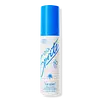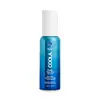What's inside
What's inside
 Key Ingredients
Key Ingredients

 Benefits
Benefits

 Concerns
Concerns

 Ingredients Side-by-side
Ingredients Side-by-side

Butyl Methoxydibenzoylmethane 2.9%
UV AbsorberEthylhexyl Salicylate 4.9%
UV AbsorberOctocrylene 9.5%
UV AbsorberAlcohol
AntimicrobialAloe Barbadensis Leaf Extract
EmollientBisabolol
MaskingButyloctyl Salicylate
Skin ConditioningButyrospermum Parkii Oil
EmollientCaffeine
Skin ConditioningCamellia Sinensis Leaf Extract
AntimicrobialCarthamus Tinctorius Seed Oil
MaskingChlorella Vulgaris Extract
Skin ConditioningNelumbo Nucifera Extract
Skin ConditioningCucumis Sativus Seed Oil
EmollientDiisooctyl Succinate
EmollientEthyl Ferulate
AntioxidantEthylhexyl Methoxycrylene
Skin ConditioningParfum
MaskingMusa Sapientum Fruit Extract
Skin ConditioningPassiflora Edulis Seed Oil
EmollientPolyester-8
Skin ConditioningTocopherol
AntioxidantVa/Butyl Maleate/Isobornyl Acrylate Copolymer
Water
Skin ConditioningButyl Methoxydibenzoylmethane 2.9%, Ethylhexyl Salicylate 4.9%, Octocrylene 9.5%, Alcohol, Aloe Barbadensis Leaf Extract, Bisabolol, Butyloctyl Salicylate, Butyrospermum Parkii Oil, Caffeine, Camellia Sinensis Leaf Extract, Carthamus Tinctorius Seed Oil, Chlorella Vulgaris Extract, Nelumbo Nucifera Extract, Cucumis Sativus Seed Oil, Diisooctyl Succinate, Ethyl Ferulate, Ethylhexyl Methoxycrylene, Parfum, Musa Sapientum Fruit Extract, Passiflora Edulis Seed Oil, Polyester-8, Tocopherol, Va/Butyl Maleate/Isobornyl Acrylate Copolymer, Water
Butyl Methoxydibenzoylmethane 2.9%
UV AbsorberEthylhexyl Salicylate 4.9%
UV AbsorberOctocrylene 9.5%
UV AbsorberAlcohol
AntimicrobialButyloctyl Salicylate
Skin ConditioningEthylhexyl Methoxycrylene
Skin ConditioningPolyester-8
Skin ConditioningParfum
MaskingVa/Butyl Maleate/Isobornyl Acrylate Copolymer
Carthamus Tinctorius Seed Oil
MaskingRubus Idaeus Seed Oil
EmollientMauritia Flexuosa Fruit Oil
Skin ConditioningLimnanthes Alba Seed Oil
Skin ConditioningBrassica Campestris Seed Oil
Skin ConditioningCamellia Sinensis Leaf Extract
AntimicrobialGlycyrrhiza Glabra Root Extract
BleachingOpuntia Ficus-Indica Flower Extract
Skin ConditioningCamelina Sativa Seed Oil
Skin ConditioningBisabolol
MaskingGlycerin
HumectantWater
Skin ConditioningEthyl Ferulate
AntioxidantDiisooctyl Succinate
EmollientButyl Methoxydibenzoylmethane 2.9%, Ethylhexyl Salicylate 4.9%, Octocrylene 9.5%, Alcohol, Butyloctyl Salicylate, Ethylhexyl Methoxycrylene, Polyester-8, Parfum, Va/Butyl Maleate/Isobornyl Acrylate Copolymer, Carthamus Tinctorius Seed Oil, Rubus Idaeus Seed Oil, Mauritia Flexuosa Fruit Oil, Limnanthes Alba Seed Oil, Brassica Campestris Seed Oil, Camellia Sinensis Leaf Extract, Glycyrrhiza Glabra Root Extract, Opuntia Ficus-Indica Flower Extract, Camelina Sativa Seed Oil, Bisabolol, Glycerin, Water, Ethyl Ferulate, Diisooctyl Succinate
 Reviews
Reviews

Ingredients Explained
These ingredients are found in both products.
Ingredients higher up in an ingredient list are typically present in a larger amount.
Alcohol comes in many different forms. Different types of alcohol will have different effects on skin. This ingredient is usually an astringent alcohol.
These alcohols are drying on the skin. They may strip away your skin's natural oils and even damage your skin barrier. Astringent alcohols may also irritate skin.
Other types of astringent alcohols include:
According to the National Rosacea Society based in the US, you should be mindful of products with these alcohols in the top half of ingredients.
Any type of sanitizing product will have high amounts of alcohol to help kill bacteria and viruses.
Fatty alcohols come from plant oils such as coconut oil. These can help hydrate the skin and are non-irritating. Some fatty alcohols include cetyl and stearyl alcohol.
Learn more about AlcoholBisabolol is famous for its skin soothing properties. It does this by blocking inflammatory signals, helping to reduce your body's reaction to irritation.
This ingredient also interferes with the process of hyperpigmentation. This can help with reducing dark spots and uneven tone.
Bisabolol is an antioxidant. Antioxidants help fight free-radicals. Free-radicals are molecules that may damage your skin cells. By fighting these free-radicals, Bisabolol may slow down signs of aging.
Studies have shown Bisabolol to have antimicrobial properties and may be a fungicide. These properties help preserve a product's shelf life.
All these properties makes bisabolol a great skin barrier helper ingredient.
Bisabolol also helps the absorption of other ingredients.
Note: Synthetic Bisabolol has been shown to be less effective.
Learn more about BisabololAlso known as Avobenzone, this ingredient is a chemical sunscreen filter that provides protection in the UV-A range.
Avobenzone is globally approved and is the most commonly used UV-A filter in the world.
Studies have found that avobenzone becomes ineffective when exposed to UV light (it is not photostable; meaning that it breaks down in sunlight). Because of this, formulations that include avobenzone will usually contain stabilizers such as octocrylene.
However, some modern formulations (looking at you, EU!) are able to stabilize avobenzone by coating the molecules.
Avobenzone does not protect against the UV-B range, so it's important to check that the sunscreen you're using contains other UV filters that do!
The highest concentration of avobenzone permitted is 3% in the US, and 5% in the EU.
Learn more about Butyl MethoxydibenzoylmethaneButyloctyl Salicylate is a chemical UV filter structurally similar to octisalate. It is a photostabilizer, SPF booster, emollient and solvent. This ingredient helps evenly spread out ingredients.
According to a manufacturer, it is suitable for pairing with micro Titanium Dioxide, Zinc Oxide, and pigments.
Photostabilizers help stabilize UV-filters and prevents them from degrading quickly.
Learn more about Butyloctyl SalicylateCamellia Sinensis Leaf Extract is derived from the leaves of the tea plant. Black tea, green tea, and oolong tea are all harvested from this plant.
This ingredient has many skin benefits:
This ingredient contains polyphenols, a strong antioxidant. Antioxidants help fight off molecules that damage skin cells.
On top of that, the antioxidants in green tea neutralize free-radicals from the sun. This gives the skin some extra UV protection, but should not replace sunscreen.
Many components of tea have anti-inflammatory properties.
Polyphenols and L-theanine help soothe the skin and reduce irritation. The caffeine in Camellia Sinensis Leaf Extract helps calm inflamed blood vessels.
Other compounds found in tea include: Vitamin Bs, linoleic acid, magnesium, calcium, iron, and zinc.
Research has shown both drinking Camellia Sinensis Leaf Tea and applying it to the skin can help boost skin elasticity and hydration. Studies also show using tea extract may reduce sebum, or oil, production.
Learn more about Camellia Sinensis Leaf ExtractCarthamus tinctorius seed oil comes from safflower, one of humanity's oldest crops.
Safflower seed oil contains a high percentage of linoleic acid and oleic acid. It also contains Vitamin E. These three components are effective moisturizers.
Vitamin E helps nourish your skin's lipid barrier. It is also a potent antioxidant. Antioxidants help fight free-radical molecules, or unstable molecules that may damage your skin cells.
Due to its high fatty acid content, this ingredient may not be malassezia folliculitis safe.
Thoughout history, safflower has been used for dying fabrics and in food as a saffron substitute.
Learn more about Carthamus Tinctorius Seed OilWe don't have a description for Diisooctyl Succinate yet.
Ethyl ferulate is an antioxidant derived from ferulic acid and ethyl alcohol. You'll most likely see this ingredient in sunscreens.
One study from 2014 found a concentration of 10% showed a similar SPF to Benzimidazole. Though this is considered a chemical UV filter, this ingredient is not listed as so. This is due to regulatory loopholes. You'll likely find this ingredient in "100% mineral" sunscreens.
This ingredient is typically found in concentrations between 0.5-1%. It is usually created synthetically or from rice bran oil.
Learn more about Ethyl FerulateThis ingredient is a photostabilizer and a chemical UV booster. It is marketed as an alternative to octocrylene.
You'll most likely find it in sunscreens to enhance stability and effectiveness of UV filters, antioxidants, and vitamin A derivatives. According to the manufacturer, this ingredient is better than octocrylene at stabilizing avobenzone.
Due to regulation loopholes, you'll likely see this ingredient in "100% mineral" sunscreens.
Learn more about Ethylhexyl MethoxycryleneEthylhexyl Salicylate is an organic compound used to block UV rays. It primarily absorbs UVB rays but offers a small amount of UVA protection as well.
Commonly found in sunscreens, Ethylhexyl Salicylate is created from salicylic acid and 2-ethylhexanol. You might know salicylic acid as the effective acne fighter ingredient and BHA.
The ethylhexanol in this ingredient is a fatty alcohol and helps hydrate your skin, similar to oils. It is an emollient, which means it traps moisture into the skin.
According to manufacturers, Ethylhexyl Salicylate absorbs UV wavelength of 295-315 nm, with a peak absorption at 307-310 nm. UVA rays are linked to long term skin damage, such as hyperpigmentation. UVB rays emit more energy and are capable of damaging our DNA. UVB rays cause sunburn.
Learn more about Ethylhexyl SalicylateOctocrylene protects skin from sun damage. It absorbs UV-B with peak absorption of 304 nm. It is a common sunscreen ingredient and often paired with avobenzone, a UVA filter. This is because octocrylene stabilizes other sunscreen ingredients by protecting them from degradation when exposed to sunlight. Octocrylene is a photostable ingredient and loses about 10% of SPF in 95 minutes.
Octocrylene also acts as an emollient, meaning it helps skin retain moisture and softens skin. It is oil-soluble and hydrophobic, enhancing water-resistant properties in a product.
Those who are using ketoprofen, a topical anti-inflammatory drug, may experience an allergic reaction when using octocrylene. It is best to speak with a healthcare professional about using sunscreens with octocrylene.
The EU allows a maximum of these concentrations:
Learn more about OctocryleneParfum is a catch-all term for an ingredient or more that is used to give a scent to products.
Also called "fragrance", this ingredient can be a blend of hundreds of chemicals or plant oils. This means every product with "fragrance" or "parfum" in the ingredients list is a different mixture.
For instance, Habanolide is a proprietary trade name for a specific aroma chemical. When used as a fragrance ingredient in cosmetics, most aroma chemicals fall under the broad labeling category of “FRAGRANCE” or “PARFUM” according to EU and US regulations.
The term 'parfum' or 'fragrance' is not regulated in many countries. In many cases, it is up to the brand to define this term.
For instance, many brands choose to label themselves as "fragrance-free" because they are not using synthetic fragrances. However, their products may still contain ingredients such as essential oils that are considered a fragrance by INCI standards.
One example is Calendula flower extract. Calendula is an essential oil that still imparts a scent or 'fragrance'.
Depending on the blend, the ingredients in the mixture can cause allergies and sensitivities on the skin. Some ingredients that are known EU allergens include linalool and citronellol.
Parfum can also be used to mask or cover an unpleasant scent.
The bottom line is: not all fragrances/parfum/ingredients are created equally. If you are worried about fragrances, we recommend taking a closer look at an ingredient. And of course, we always recommend speaking with a professional.
Learn more about ParfumThis ingredient is also known as Polycrylene. It is a UV photostabilizer and often used in sunscreens as an alternative to octocrylene.
Polycrylene is used to stabilize other UV filters, especially avobenzone, which is known to degrade rapidly without stabilizers. It also absorbs UVB light, but is only about 1/3 as effective as octocrylene.
At its maximum recommended strength of 4%, this ingredient is not likely to make a significant contribution to SPF factor. Polycrylene has a large molecular weight so it's unlikely to penetrate skin.
Although rare, this ingredient can cause contact dermatitis.
Due to regulatory loopholes, you'll be able to find this chemical UV filter in "100% mineral" sunscreens.
Learn more about Polyester-8We don't have a description for Va/Butyl Maleate/Isobornyl Acrylate Copolymer yet.
Water. It's the most common cosmetic ingredient of all. You'll usually see it at the top of ingredient lists, meaning that it makes up the largest part of the product.
So why is it so popular? Water most often acts as a solvent - this means that it helps dissolve other ingredients into the formulation.
You'll also recognize water as that liquid we all need to stay alive. If you see this, drink a glass of water. Stay hydrated!
Learn more about Water